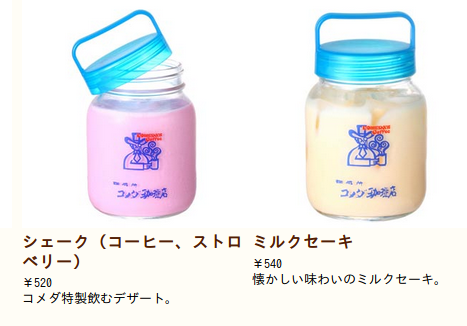For goodness shake
Visiting the ubiquitous Japanese coffee chain Komeda’s the other day, my girlfriend noticed something odd about the menu.

Komeda’s serves several kinds of shakes. The names of these shakes are written in katakana (standard for loanwords), but what’s odd is the spelling inconsistency. Here’s the romanized versions:
- シェーク (コーヒー、ベリー)= shēku (kōhī, berī)
- ミルクセーキ = mirukusēki
Which can be translated as:
- Shake (coffee, berry)
- Milkshake
So both menu items are a shake of some sort, but shake is spelt in two different ways - shēku and sēki).
My girlfriend was confused by this so she asked our Japanese friend why there were two different words in Japanese for the same thing. Our friend said that milkshake had been borrowed into the language earlier, when Japanese people had less experience distinguishing between sounds in foreign words.
So the pronunciation of milkshake is a a throwback to a different period of English-Japanese language contact.
Looking at the word itself, shake doesn’t gel very well with Japanese phonotactics, as you can’t have */ʃe/, nor can you have /k/ word finally.
With the older word, sēki the vowel sound in shake is fairly closely approximated with a long vowel [eː], but the initial consonant is changed from /ʃ/ to /s/ and a vowel is inserted word finally, satisfying the strong preference for CV structure in Japanese. Interestingly, the vowel that gets tacked on to the end is /i/. Normally, you’d expect /u/ (realized as [ɯ]) to follow [k] in this role, e.g. ロック rokku ‘rock (music).’ It’s definitely a very non-standard way of adapting a loanword.
Then there’s シェーク shēku which is much closer to what we say in English, and begins with a very un-Japanese /ʃe/. New sound combinations have gradually filtered into the language during the most recent 150 years of language contact with English. Concessions like /ʃe/ highlight changes in how loanwords are adopted into Japanese.
Right, so the story so far goes something like: Japanese speakers used to have more trouble discriminating and producing sounds absent in their language, but increasing language contact has changed this. New phonemes have been introduced as a result. Older loanwords illustrate how Japanese speakers dealt with unfamiliar speech sounds in the past.
Semantic shake-up
But are sēki and shēku the same morpheme? In fact, is sēki really even a separate morpheme at all, given it only occurs in this particular loan word?
Consulting the online dictionary jisho.org, ミルクシェーク mirukushēku is listed as an alternative spelling for ミルクセーキ mirukusēki, so there’s at least a superficial connection, but not necessarily a direct equivalence.
To get a better idea of what Japanese people think of when they hear the word mirukusēki, I went to the Japanese Wikipedia entry. Apparently there are two different drinks the word can refer to - French-style milkshakes and American-style milkshakes. (Note that this page differs significantly from the English entry for “Milkshake.") According to the entry, French-style milkshakes are made from milk, egg yolk, sugar and vanilla essence, while American-style milkshakes are typically made with milk, icecream, sugar and vanilla essence, possibly with the addition of other flavourings.
However, searching for シェーク shēku (also spelt シェイク sheiku) instead leads to a page of disambiguations. The relevant sense is second on the list:
アメリカンスタイルのミルクセーキのこと。マックシェイクなど
This translates to: “An American-style milkshake, for example a McShake.” So although the sēki in ミルクセーキ mirukusēki is interchangeable with シェーク shēku without changing the meaning of the word, シェーク shēku on its own always refers to American-style milkshakes.
Finally, I asked a (Japanese) colleague at work whether she thought there was any difference between the words ミルクセーキ, ミルクシェーク and シェーク. This proved a difficult question. Because I couldn’t really get a definite answer, I showed here the image of the Komeda’s menu. I then asked, “Are these drinks the same thing, except for the flavour?” To this she replied, “No, definitely not.” She described the first item as being thicker, more like a smoothie, whereas the second was more like a chilled, sweetened milk-drink. This fits in with shēku being used exclusively for thick, American-style shakes.
So, it seems sēki and shēku differ in semantics as well as phonology. Some speakers recognize a limited morphological status for sēki by itself, though this doesn’t extend beyond the word for milkshake.
Dairy me
This is just one example of the wild1 world of Japanese loanword phonology. As always, what appeared to be a simple topic at first quickly turned into an unexpectedly complicated one. Time for a chilled, sweetened milk drink!
-
Okay, it’s not that wild at all, but it is really interesting. ↩︎